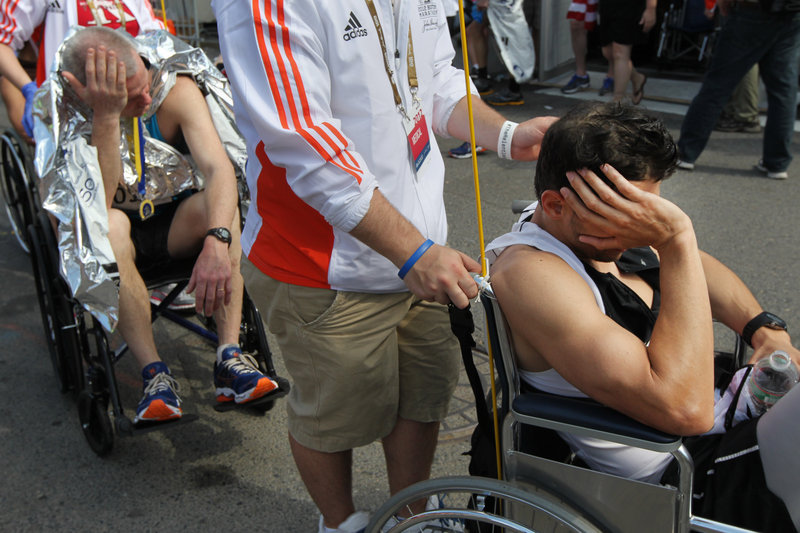After 14 years of volunteering in the medical tent at TD Bank Beach to Beacon 10K Road Race, Mylan Cohen figured a visit to this year’s Boston Marathon was in order.
It was more than half a century after his grandfather was the official physician for the Boston Marathon, and Cohen — a cardiologist from Cape Elizabeth — planned to go to Boston to observe. Instead, the marathon’s medical director put Cohen to work as head of the heat deck, an add-on to the main medical tent.
And he was plenty busy when scores of runners suffered from heat exhaustion on that unseasonable, scorching day this April. Because of what Cohen and his colleagues had learned in the Beach to Beacon tent about the importance of ice-bath immersion and rectal thermometers, lives were saved.
“Oh, without a doubt,” said Chris Troyanos, the medical coordinator at both Boston (run on Patriots Day in April) and Beach to Beacon (run the first weekend in August), who is also director of sports medicine at Laselle College in Newton, Mass. The Boston Marathon “is not traditionally a hot-weather race, so we’re not as experienced (with heat) as the medical team at the Beach to Beacon race.”
Cohen, who moved into his Cape Elizabeth home on the very day of the inaugural Beach to Beacon in 1998, will be at his 15th race on Saturday and any runner who hits the roads should know that the medical staff is prepared for emergency situations.
RUNNERS GET OVERHEATED
Runners can collapse for a variety of reasons. It might be cardiac arrest. It could be heatstroke. At longer races, drinking too much water — resulting in low sodium levels in the blood — can lead to problems.
Two runners have died at the Boston Marathon, one in 1996 from a cardiac event and another in 2002 from hyponatremia, or low blood sodium.
The Beach to Beacon has never had a casualty — and chances of a fatal event are significantly diminished with a 6.2-mile race compared to the 26.2-mile marathon distance — but the medical volunteers regularly deal with overheated runners. One even became combative enough to throw a punch at a caregiver while in an ambulance.
“That’s just the effect of heat on the brain,” said Dr. Michael Baumann, chief of emergency medicine at Maine Medical Center and medical director, along with Cohen, at Beach to Beacon. “Some of the people are 107 (degrees). When the brain gets that hot, they are not really that aware and they’re quite agitated.”
The brain isn’t the only vulnerable organ. The liver and kidneys are also stressed by heat. Troyanos said he’s heard of athletes who weren’t cooled quickly enough “who are still on dialysis and will be for the rest of their lives.”
One of the leading experts on the topic of exercise-related heat stroke is Dr. Douglas Casa, chief operating officer of the Korey Stringer Institute at the University of Connecticut. Stringer, you may remember, is the professional football player who died of heatstroke 11 years ago during the Minnesota Vikings’ preseason training camp.
The institute that bears his name is dedicated to research, education and advocacy about the prevention of sudden death in sports, with a particular emphasis on exertional heatstroke.
“The key to heatstroke is getting their temperature under 104 as fast as humanly possible,” Casa said by phone from Storrs, Conn. “If you can do that within 30 minutes of collapse — and we’ve tracked over 2,000 cases of heatstroke in the military and in athletics in a variety of scenarios and venues — we found it has been 100-percent survivable and with no long-term complications.”
The best way to measure core temperature, Casa said, is with a rectal thermometer. Newer, flexible electronic probes allow caregivers to continually monitor a patient’s temperature while the overheated runner is immersed in a 50-gallon livestock tank made of durable plastic and filled with ice and water. Arms and legs hang over the sides, and someone supports the runner’s head.
Once the core temperature drops to 102, the runner is removed from the tub in order to avoid hypothermia, which occurs when the body temperature falls too low and can be fatal.
Casa has done the research to support such protocol. In 2006, at the invitation of Beach to Beacon organizers, he advocated for it at a pre-race sports medicine symposium held at Maine Medical Center. He said Beach to Beacon and the Falmouth (Mass.) 7-Mile Road Race, which follows it by a week, are great examples of state-of-the-art treatment.
BOSTON POSES CHALLENGE
The Boston Marathon is — or was — a different story, said Casa, who is no longer welcome there despite 14 years of volunteer service. In 2010 he clashed with a physician in the medical tent over how to treat a potential heatstroke victim.
The confrontation arose from the fact that, with the finish-line tent being in Boston, the city’s Emergency Medical Services, or Boston EMS, has jurisdiction. During the other 364 days of each year, Boston EMS’ dealings with heatstroke are more likely to involve, say, elderly residents of apartment buildings without air conditioning.
A perfectly reasonable approach to such a patient is the use of a temporal (swiped across the forehead) or tympanic (ear) thermometer.
Such methods, Casa has learned, do not give accurate body-temperature readings for sweaty athletes.
Then there is the matter of the 30-minute window. In the early days of the Beach to Beacon, Cohen said, cooling towels were often used.
“But what we learned,” Cohen said, “is that the most efficient way to cool a person with heatstroke — and heatstroke is a medical emergency — is by immersing the patient in ice water.”
When core temperature rises over 104, changes in cognition are common. Above 106 and “you can have delirium, stupor, seizures or even coma,” Cohen said.
In some jurisdictions, protocol for heatstroke patients may call for transport to a hospital. Again, for the overheated apartment-dweller, that may work. For the athlete whose true core temperature is often higher than can be measured by a temporal thermometer, such a decision could be fatal.
In an effort to be both politically and medically correct this spring, organizers of the Boston Marathon prepared a distinct triage area for the traditional protocol of Boston EMS and another, with Cohen in charge, using Beach to Beacon methods centered around immersion tubs and rectal thermometers. The day’s record-setting heat sent more than 2,000 runners into treatment, Troyanos said, and at least 60 of them involved some type of ice immersion. There was even one core-temperature reading of 109 degrees.
As for the Boston EMS triage area, “we never touched it,” Cohen said. “In the past, I think there had been tension, but it was very smooth. I think this year in Boston was a turning point in how they treat hot patients.”
Medicine is a continuously evolving field, and physicians are always learning new ways to treat patients. Those topics, and others, will be explored at another pre-race symposium scheduled for Thursday night in the Dana Center Auditorium at Maine Medical Center in Portland.
Among the speakers will be race founder Joan Benoit Samuelson (longevity in sport), physicians Erin Dawson-Chalat (running while pregnant) and John Devlin (diabetic athlete) and medical tent veterans Troyanos, Baumann and Cohen.
Who knows? Maybe Boston will be a hot topic.
As the marathon medical rush died down this April and Cohen had a chance to relax with his wife, Maya (who serves as the Beach to Beacon volunteer coordinator), they understood why Dr. A.M. Cohen kept coming back to Boston.
“I looked at Maya at the end and said, ‘You know what, this is really cool,’ ” Cohen said. “We’re doing this every year.”
Staff Writer Glenn Jordan can be contacted at 791-6425 or at:
gjordan@pressherald.com
Twitter: GlennJordanPPH
Send questions/comments to the editors.





Success. Please wait for the page to reload. If the page does not reload within 5 seconds, please refresh the page.
Enter your email and password to access comments.
Hi, to comment on stories you must . This profile is in addition to your subscription and website login.
Already have a commenting profile? .
Invalid username/password.
Please check your email to confirm and complete your registration.
Only subscribers are eligible to post comments. Please subscribe or login first for digital access. Here’s why.
Use the form below to reset your password. When you've submitted your account email, we will send an email with a reset code.